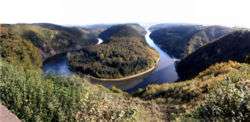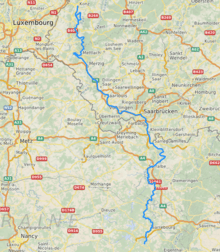Saar (river)
The Saar (/sɑːr/, also US: /zɑːr/, German: [zaːɐ̯] (![]()
| Saar | |
|---|---|
 Saar loop at Mettlach. | |
 | |
| Location | |
| Country | France, Germany |
| Physical characteristics | |
| Source | |
| • location | Vosges mountains |
| • elevation | ±800 m (2,600 ft) |
| Mouth | |
• location | Moselle |
• coordinates | 49°42′5″N 6°34′11″E |
| Length | 246 km (153 mi) |
| Basin size | 7,431 km2 (2,869 sq mi) |
| Discharge | |
| • average | 75 m3/s (2,600 cu ft/s) |
| Basin features | |
| Progression | Moselle→ Rhine→ North Sea |

The Saar was very important for the Saarland coal, iron and steel industries. Raw materials and finished products were shipped on it by water via the Canal des houillères de la Sarre, the Marne-Rhine Canal and the Rhine, for instance, to the Ruhr area or the port of Rotterdam.
Although the German part of the Saar has been upgraded to a waterway by deepening, construction of sluices and straightening, there is no significant shipping traffic.
The Saar flows through the following departments of France, states of Germany and towns:
- Moselle (F): Abreschviller (Sarre Rouge), Lorquin, Sarrebourg, Fénétrange
- Bas-Rhin (F): Sarre-Union
- Moselle (F): Sarralbe, Sarreguemines
- Saarland (D): Saarbrücken, Völklingen, Wadgassen, Bous, Saarlouis, Dillingen, Merzig
- Rhineland-Palatinate (D): Saarburg, Konz.
On the banks of the Saar is the UNESCO-World Heritage Site Völklinger Hütte. At Mettlach the Saar passes the well-known Saar loop. The lower Saar in Rhineland-Palatinate is a winegrowing region of some importance, producing mostly Riesling. Until the early 20th century, much more wine was grown on the banks of the Saar, reaching much further up from the mouth of the river, up to Saarbrücken. Only in the early 21st century have some enterprising farmers from the Saarland area started experimenting with winegrowing again.
The name Saar stems from the Celtic word sara (streaming water), and the Roman name of the river, saravus.
Hydrology
- Length: 246 kilometres (153 mi), (126 kilometres in France, 120 kilometres in Germany)
- Catchment area: 7,431 square kilometres (2,869 sq mi)

External links
